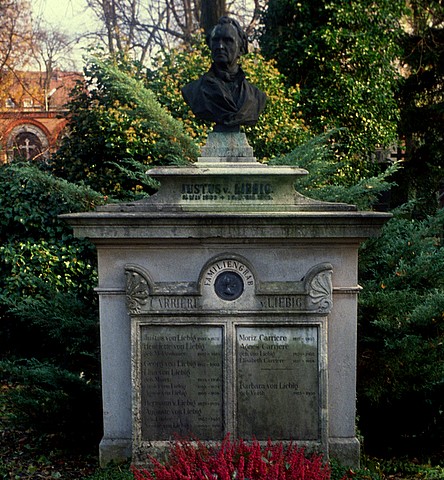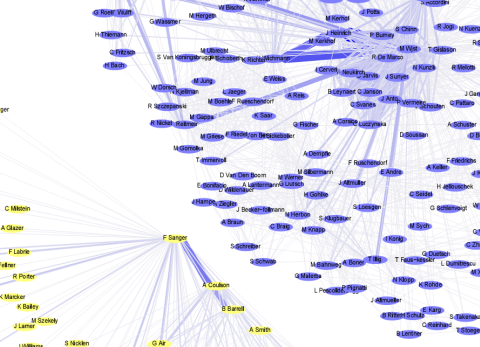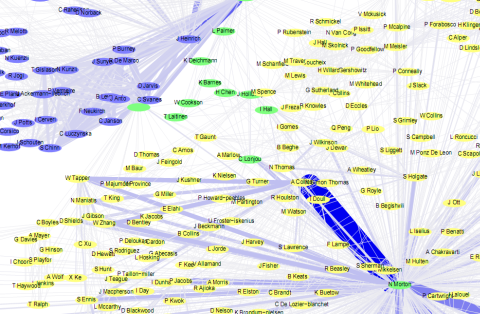Another German University carries his name, but his tombstone is here in Munich: Alter Südlichen Friedhof, Thalkirchner Str. 240, Eingang Kapuzinerstr., D-80469 München.
Tag Archives: History + Insights
The epigenetic landscape
What I always feared, but couldn’t believe, is now confirmed by renowned experts in a new Cell editorial
Historically, the word “epigenetics” was used to describe events that could not be explained by genetic principles.
It goes back to Conrad Waddington – and describes now such bizarre and inexplicable features like paramutation in maize, position effetc variegation in Drosophila and methylation in humans. There is a nice analogy of the classical 1957 epigenetic landscape figure of Waddington where the course of the ball is influenced by hillls and valleys where it finally arrives – the Pinball arcade game
known factors that may regulate epigenetic phenomena are shown direcing the complex movements of pinballs (cells) across the elegant landscape … no specific order of molecular events is implied; as such a sequence remains unknown. Effector proteins recognize specific histone modifications…
[MEDIA=19]
Clockworks
Do you know how a mechanical clock works? Here is my attempt to explain this to my children:
[MEDIA=20]
The power (the white solid wheel at 4 o’clock) is attached to a series of wheels (black, green, pink) that finally carry the hands.
The clock would run as fast as possible if the power wheel would not limited by a second set of wheels (blue, yellow, red) leading to white escapement, that is leading to a periodic repetitive action allowing the power to escape in small bursts rather than drain away all at once.
The trick is with the special form of the white escapement wheel at 12 o’clock which lifts up the pallet arbor periodically. The pallet arbor has 2 pallets, which enter the spaces between the wheel teeth; it rocks back and forth in a consistent way is it also connected to a pendulum. As each tooth moves in and out of the teeth, it allows the wheel to turn in repetitive actions.
More clocks photos at human clock; we will need this principle at a later stage.
Science crowd-sourced
I have recently read about a round-table discussion on “so called experts” – a frequent topic in environmental circles. Have to say that I do not fear so much half-way baked knowledge – even renowned experts are occasionally slipping to a closely related field where they are no expert at all. Or do you believe that a Nobel prize winner in physics has any primacy in ethics?
In the same vein, there is comment in nature medicine about Wikipedia – complaining that a 4th year medical student (“who is barely old enough to buy beer”) has such a large influence on medical writing at Wikipedia. As there doesn’t follow any details of his major errors or misunderstandings, I conclude that this comment is more about the beer drinking habits of the author Brandom Keim.
Anyway, there are quite interesting new sites by medical doctors like Gantyd (get a note from your doctor) with 3000 topic pages, 200 editors from 6 countries) or Ask Dr. Wiki (4 editors, clinical notes, pearls, ECGs, X-ray images and coronary angiograms) all worth a look.
Allergy research 1900-1933
Here is a brief summary of allergy research as an index to Schadewaldt
1900 Posselt (1:370; 4:44)
enteritis membranacea used synonymous to asthma
1902 Kratschmer (2:100)
hay fever is triggered by trigeminus reflex Continue reading Allergy research 1900-1933
It’ s a small world
Sometimes erroneously described as global village phenomenon the notion of a small world goes back to an experiment by Stanley Milgram (who became famous with the “obedience to authority” experiment – I did not know until last weeks that the punishing experiments had been repeated here in Munich where 85 percent of the subjects continued until to the end!).
The small world theory says that everyone in the world can be reached through a short chain of social acquaintances. The concept gave rise to the famous phrase of phrase six degrees of separation – I believe that a scientist may even reach another scientist in 4-5 steps.
My first PubNet example here is to reach F. Sanger by joint co-authors. This doesn’t work – my estimate would be 3 intermediary steps.
My second PubNet example is to reach N. Morton (the foreword of his anniversary book says that a qualification of a genetic epidemiologist can be counted as “Newton”-points – the number of joint publications with Professor Morton).
Addendum 8/7/08
Arxive.org has the largest study so far: 6,6 steps in 30 billion messenger conversations among 240 million people.
An alternative to ISI’s impact empire
In my experience Google Scholar already shows more counts than ISI Web of Science. A new paper in first monday highlights another search engine that allows even truncation of search terms*: Exalead is a European (Paris) based search engine which does allow truncation and has a nice interface too.
Addendum
A new series of papers in the BMJ discusses some alarming consequences of “impact” measurements
The impact factor now has a worrying influence not just on publication of papers but on the science behind them too … One consequence has been to make universities prioritise laboratory based life sciences that produce research published in the highest impact factor journals, causing substantial damage to the clinical research base.
that goes beyond the previous view of Seglen.
Search engines are about algorithms w/o structure, while databases are about structure w/o algorithms
NYT today has an interesting article about freebase (no, nothing about cocaine here) a forthcoming sematic web approach.
On the Web, there are few rules governing how information should be organized. But in the Metaweb database, to be named Freebase, information will be structured to make it possible for software programs to discern relationships and even meaning.
For example, an entry for California’s governor, Arnold Schwarzenegger, would be entered as a topic that would include a variety of attributes or “views†describing him as an actor, athlete and politician — listing them in a highly structured way in the database.
That would make it possible for programmers and Web developers to write programs allowing Internet users to pose queries that might produce a simple, useful answer rather than a long list of documents.
Valleywag – the famous tech gossip – also has something about semantic webs.
Fail better
I truly liked the recent Sjoblom study while a new Science letter now raises heavy criticism:
… put into stark reality the challenges facing the Human Cancer Genome Project (HCGP). One wonders about the merits of such high-cost, low-efficiency, and ultimately descriptive-type “brute force” studies. Although previously unknown mutated genes were unearthed, the functional consequences of most of these and their actual role in tumorigenesis are unknown, and even with that knowledge we are a long way from identifying new therapeutic targets.
This seems to be the open wound of modern biology: all these high throughput driven genotyping / expression profiling / metabolome scanning approaches are mainly money & impact & activity driven – parameter or hypothesis-free has become a fashionable buzz phrase while only a few years ago it would have been an affront to every serious researcher.
Funny to see also the new Nature initiative opentextmining.org as nobody wants to read the results of these studies. So at least computers should be able to do that. Fail better…
Addendum
Similar criticism of the Neanderthal studies but a different argument
However, although such comparisons are of interest, it is not the static genome but rather the dynamic proteome that determines the phenotype of an organism. Salient examples include the caterpillar and the tadpole, which share
genomes with the butterfly and frog, respectively, but which have very different proteomes making them into very different organisms.
Thus, rather than performing untargeted comparisons of sizable genomes, we suggest that it might be more useful to address this question using a standard hypothesis-driven approach.
Sauerbruch and Rascher
Last week I went to Bavaria’s largest book market and found a book that I wanted to read for a long time – the 1950 autobiography of Ritterkreuzträger, Generalarzt, Staatsrat, Geheimrat, Prof. Dr. med., Dr. med. h.c. Ferdinand Sauerbruch, emeritus director of the surgical university clinic in Berlin – and found unexpected connections to Sigmund Rascher.
P 538
Sehr interessant war für mich ein Teilgebiet der gesamten Wehr-Medizin: die Luftfahrt-Medizin. Sie erwuchs auf der Grundlage psychologischer Untersuchungen und klinischer Erfahrungen. Es ist aber ganz selbstverständlich, und man muß es einmal aussprechen, daß die Forschung wertvollste Anregungen aus der Kriegstätigkeit der Sanitätsoffiziere gewonnen hat.
P 558
Ich will mich nicht zum sogenannten “Ärzteprozeß” in Nürnberg äußern. Ich kann hier nur versichern, daß heute manche Ärzte, die sicher nicht weniger “schuldig” waren, in aller Gemütsruhe ihrer Praxis nachgehen. Ich könnte ein Dutzend Namen nennen, aber das brächte die anderen nicht wieder zum Leben, sondern möglicherweise nur neue Opfer der so höchst zweifelhaften “irdischen Gerechtigkeit”.
translation
Mitscherlich/ Mielke reported that Sauerbruch attended the “3. Arbeitstagung der beratenden Ärzte” in May 1943 moderated by Karl Gebhardt where experiments from concentration camp Ravenbrück have been reported. According to Klee (Auschwitz, 1997, P 199) Sauerbruch issued a temporary restraining order against Mitscherlich that it had not been known that these experiments were performed on prisoners.
Reading now about Sauerbruchs’ fascination of the Rascher experiments -valuable contribution- and his speculations about -“guilt”- in quotation marks I think that this attitude can not be atrributed to dementia praecox as has been done before.
At its heart
43 folders writes:
Remember that your blog is only incidentally a publishing system or a public website. At its heart, your blog represents the evolving expression of your most passionately held ideas. It’s a conversation you’re holding up with the world and with yourself — a place where you can watch your own thoughts take different shapes and occasionally surprise you with where they end up…
wow – couldn’t say that in a better way.
Less is more
–Day 3 of Just Science Week–
Peer review certainly plays a major role in assuring quality of science. There are many positive aspects of peer review (plus a few disadvantages like promoting mainstream). Systematic research on peer review, however, has been largely absent until 2 decades ago; after 5 international conferences on peer review there is now also the WAME association of journal editors. Over the years, I have experienced the “cumulative wisdom” thrown at my own papers and of course developed my own style when doing reviews. Last week PLOS medicine published an interesting study who makes a good peer review:
These reviewers had done 2,856 reviews of 1,484 separate manuscripts during a four-year study period, and during this time the quality of the reviews had been rated by the journal’s editors. Surprisingly, most variables, including academic rank, formal training in critical appraisal or statistics, or status as principal investigator of a grant, failed to predict performance of higher-quality reviews. The only significant predictors of quality were working in a university-operated hospital versus other teaching environment and relative youth (under ten years of experience after finishing training), and even these were only weak predictors.
The first finding may be unimportant for non-medics but the second may apply to a larger audience. What I fear – and that is usually not mentioned in the current discussion – that the peer review system is slowly suffocating. The willingness to do this (unpaid & extra) work is going down as papers (at least in my field) are produced more and more an industrial mass production level. I am getting a review request nearly every second day while I do need between 30 minutes and 3 hours for a paper. So, less is more.
Addendum
For a follow up go to sciencesque, a scenario how science in the post-review phase will work.
Resilience
Yesterday I heard for the first time of this psychology term. It describes how humans cope with stress, anger or other negative events – even over long time periods. Some people give up but others still grow (“skipjacks”). Seems that this trait can be immedately tested in scientists ;-) there is even a journal Disaster.
Enter without knocking if you can
This was posted at the door of Max Delbrück (1906-2006) in Pasadena – and quoted from the wonderful biography of E.P. Fischer his last Ph.D. student.
/-/
“Licht und Leben” (or “light and life”) is a wonderful narrative that I really enjoyed, with a lot of informative figures and tables.
I wonder why this biography never appeared in English, why neither institutes in Berlin, Cologne or Constance (where Delbrück teached) are even linking to it. E.P. Fischers book tells the story about an interesting man dedicated to science – who learned physics and applied sound principles to biology. “Enter without knocking” does not have any special meaning (as E.P. Fischer confirmed me) it was simply a rough-running door. Besides the biographical sketch and the detailed description of phages and phycomyces (p15) there are many moments in time that I really liked very much.
/-/
Hershey (with whom he shared the Nobel in 1969) should give a lecture and asked about the background of the audience. Max Delbrück answered by a postcard 6/1/1943: think of “complete ignorance and infinite intelligence” – the lecture became a success.
/-/
Delbrück always emphasized (p 148) that data should only be augmented by those who can put old data into new hypotheses. He even said “enough data” as thinking about current experiments is being as important as doing new ones. Both, thinking and doing experiments, should even be more important than publishing (his lifetime list has 115 items). Writing up results should serve as a method to connect what is currently known and what will be known. Delbrück even suggested to spend – “one day per week without pipettes”.
/-/
From an interview (p 240): “Genetic engeneering may possibly be a large thread for the future but possible also the biggest hope”.
/-/
Delbrück was a great admirer of Eliot, Rilke and of Beckett. Samuel Beckett in “Waiting for Godot” probably inspired “Licht und Leben” (p 260): “We give birth astride a grave, the light gleams an instant, then there is night once more.”
Addendum
Page 239 contains a mystery: In 1978 Delbrück gave a lecture at Caltech where he wanted to include a citation from Kierkegaard: “Wissen ist eine Sache der Einstellung, eine Leidenschaft, eigentlich eine unerlaubte Einstellung. Denn der Zwang zum Wissen ist wie Trunksucht, wie Liebesverlangen, wie Mordlust, in dem sie einen Charakter aus dem Gleichgewicht wirft. Es stimmt doch gar nicht, daß der Wissenschaftler hinter der Wahrheit her ist. Sie ist hinter ihm her. Er leidet unter ihr.” Delbrück, however, could not find the correct source, even announced to pay 50$ for it. I also looked at my library but couldn´t locate it – who knows the source?
Mirror neurons
I found an interesting extension of my self blog at Edge
Five and a half years ago, Edge published a notable essay by neuroscientist V.S. Ramachandran, entitled MIRROR NEURONS and imitation learning as the driving force behind “the great leap forward” …
And, one year ago, we published a related essay, Mirror Neurons and the Brain in a Vat [1.10.06], which further developed this set of ideas …
Here, for the Edge 10th Anniversary Essay, we are pleased to present a new work, “The Neurology of Self-Awareness”, in which “Rama” explores the concept of the self, tying in the ideas of researchers such as Horace Barlow, Nick Humphrey, David Premack and Marvin Minsky (among others), who have suggested that consciousness may have evolved primarily in a social context.
Ramachandran shows an interesting development – by chance quite similar what I am currently reading from Alfred Adler and his scholar Rudolf Dreikurs: children (and adults) want to be accepted as individuals and want to be at the same time part of a group. Martin Buber comes to my mind “Der Mensch wird erst am Du zum Ich”. Yea, yea.
Don’t miss the NYPL digital gallery for a more detailed view of mirror neurons.



